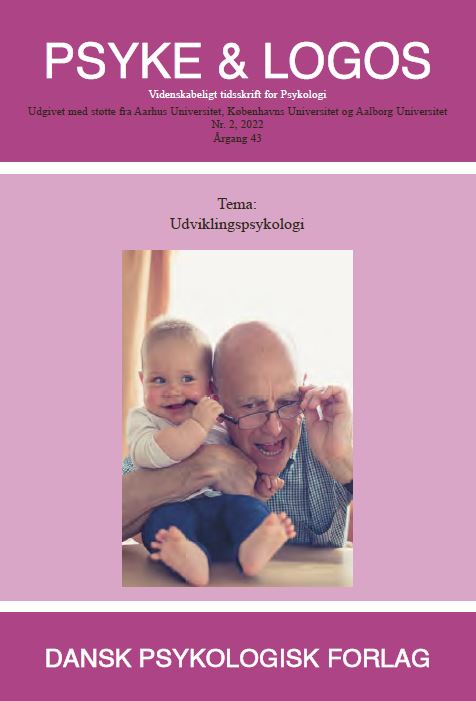Spædbørns sociale udviklingssituation – med fokus på emotionelle relationer og udvikling af intentionel orientering
DOI:
https://doi.org/10.7146/pl.v43i2.137302Nøgleord:
Spædbørns udvikling, emotionel kommunikation, intentionel orientering, agency, sociale udviklingssituation, interaktive observationsmetodeResumé
De sidste 70 år har kognitiv forskning inden for spædbørneområdet
ført til en opfattelse af, at spædbørn fra fødslen er aktivt
orienteret mod omverdenen. Men ikke alle forskningsretninger
ser børns ”agency” og intentionelle orientering som naturgivent,
hvilket forskning i døgninstitutioner efter 2. verdenskrig
har dokumenteret. For spædbørn er den emotionelle kommunikation
i bred betydning vigtig, hvor den kropslige kommunikation
mellem barn og dets omsorgspersoner allerede fra fødslen
danner grundlag for dets udvikling af en intentionel orientering
mod omverdenen. Et spædbarns biologiske udvikling,
sammen med ændring i institutionelle praksisser, medfører, at
omsorgspersonernes kommunikation med barnet ændrer sig.
Denne kommunikative interaktion mellem barn og omsorgsperson
skaber barnets sociale udviklingssituation. En vurdering af
et barns udvikling indebærer således, at barnet må ses i sin
relation til og i samspil med andre mennesker. Hvordan dette
samspil ændrer sig i spædbarnsperioden og medfører udvikling
af barnets ”agency”, illustreres med, hvordan legescenarier
mellem far og søn ændrer sig i barnets første leveår. I en sådan
sammenhæng er det barnets udviklingssituation som helhed,
der må vurderes, og den, der vurderer, indgår derfor også i
relation til barnet og bliver derved også en del af barnets sociale
situation. Denne dobbelte relationelle tilgang har dannet
grundlag for den interaktive observationsmetode, hvor målet er
en forståelse af barnets udviklingssituation, som inddrager dets
intentionelle orientering – barnets perspektiv.
Referencer
Bruner, J.S. (1968). Processes of Cognitive Growth: Infancy. Heinz Werner Lectures. 20.
https://commons.clarku.edu/heinz-werner-lectures/20.
Bruner, J.S. (1972). Nature and uses of immaturity. American Psychologist, 27(8), 687-
https://doi.org/10.1037/h0033144.
Connolly, K. & Bruner, J.S. (red.) (1974). The Growth of Competence. Academic Press.
Delafield-Butt, J.T. & Trevarthen, C. (2015). The ontogenesis of narrative: From moving
to meaning. Frontiers in Psychology, 6, 1157. https://doi.org/10.3389/fpsyg.2015.01157.
Grønborg, L. (2012). Forskeren og felten: et dobbelt spejl. Om brugen af subjektivitet i
deltagerobservationer. I: M. Petersen, J. Klitmøller & K. Nielsen (red.), Deltagerobservation
(s. 135-148). Hans Reitzel.
Hedegaard, M. (1984). Interaktionsbasered beskrivelse af småbørn og børnehavebørn i
deres dagligdag. Psykologisk skriftserie, 9(4).
Hedegaard, M. (1990/2013). Beskrivelse af småbørn. Aarhus University Press.
Hedegaard, M. (2009). Children’s development from a cultural-historical approach: Children’s
activity in everyday local settings as foundation for their development. Mind
culture and Activity, 16(1), 64-81.
Hedegaard, M. (2014). The significance of demands and motives across practices in
children’s learning and development: An analysis of learning in home and school.
Learning, Social Interaction and Culture, 3, 188-194.
Hedegaard, M. (2012). Principper for tolkning af børns udvikling gennem observation.
I: M. Petersen, J. Klitmøller & K. Nielsen (red.), Deltagerobservation (s. 161-177).
Hans Reitzel.
Kagan, J. (1973). Change and continuity in infancy. Wiley.
Kokkinaki, T.S., Vasdekis, V.G.S., Koufaki, Z.E. & Trevarthen, C.B. (2017). Coordination
of emotions in mother-infant dialogues. Infant and Child Development, 26(2).
https://doi.org/10.1002/icd.1973.
Li, L., Ridgway, A. & Quiñones, G. (2021). Moral imagination: Creating affective values
through toddlers’ joint play. Learning, Culture and Social Interaction, 30. https://doi.
org/10.1016/j.lcsi.2020.100435.
Lisina, M.S. (1985). Child-Adults-Peers. Patterns of Communication. Progress.
Meltzoff, A.N. & Moore, M.K. (1983). Newborn infants imitate adult facial gestures.
Child Development, 54, 702-709.
Merleau-Ponty, M. (1962). Phenomenology of Perception. Routledge & Kegan Paul.
Piaget, J. (1955). The Construction of Reality in the Child. Routledge & Kegan Paul.
Poliavanova, K.N. (2015). The psychology of age-related crises. Journal of Russian &
East European Psychology, 52(2), 59-68.
Quiñones, G., Li, L. & Ridgway. A. (2017). Transitory moments as “affective moments
of action” in toddler play. I: G. Quiñones, L. Li & A. Ridgway (red.), Studying babies
and toddlers (s. 175-102). Springer.
Rogoff, B. (2003). The Cultural Nature of Human Development. Oxford University
Press.
Rogoff, B. (1981). Adults and peers as agents of socialization: A highland guatemalan
profile. Ethos, 9, 18-36. https://doi.org/10.1525/eth.1981.9.1.02a00030.
Schaffer, R. (1990). Making Decisions About Children. Blackwell.
Spradley, J.P. (1980). Participant Observation. Wadsworth.
Spitz, R.A. (1945). Hospitalism. An inquiry into the genesis of psychiatric conditions in
early childhood. The Psychoanalytic Study of the Child, 1(1), 53-74.
Stern, D. (1985/1998). The Interpersonal World of the Infant. Basic Books.
Trevarthen, C. (1980). The foundation of intersubjectivity: Understandings in infants.
I: D.R. Olson (red.), Developmental Psychology and Society (s. 46-95). Macmillan.
Trevarthen, C. (1993). The function of emotion in early infant communication and development.
I: J. Nadel & L. Camaioni (red.), New Perspectives on Early Communication
Development. Routledge.
Trevarthen, C. (2005). Action and emotion in development of the human self, its sociability
and cultural intelligence: ”Why infants have feelings like ours”. I: J. Nadeland & D.
Muir (red.), Emotional Development (s. 61-91). Oxford University Press.
Trevarthen, C. (2011a). What young children give to their learning making education
work to sustain a community and its culture. European Early Childhood, Education
Research Journal, 19(2), 173-193.
Trevarthen, C. (2011b). What is it like to be a person who knows nothing? Defining the
active intersubjective mind of a newborn human being. Infant and Child Development,
(4), 119-135.
Vygotskij, L.S. (1991). The environment. I: R. v. Veer & J. Valsiner (red.), Understanding
Vygotsky: A Quest for Synthesis (s. 338-354). Blackwell Publishing.
Vygotskij, L.S. (1998). The Collected Works of L.S. Vygotsky: Vol. 5. Child Psychology.
Plenum Press.
Vygotskij, L.S. (2019). Vygotsky’s Pedological Works. Vol. 1. Foundations and Pedology.
Springer Nature.
Vygotskij, L.S. (2021). L.S. Vygotsky’s Pedological Works. Vol. 2. Springer.
Wartofsky, M. (1983). The child’s construction of the world and the world’s construction
of the child: From historical epistemology to historical psychology. I: F.S. Kessel &
A.W. Siegel (red.), The Child and Other Cultural Inventions (s. 188-215). Praeger.
Downloads
Publiceret
Citation/Eksport
Nummer
Sektion
Licens
Ophavsret er tidsskriftets og forfatternes. Det er gældende praksis, at artikler publiceret i Psyke & Logos, som efterfølgende oversættes til andet sprog, af forfatteren frit kan publiceres i internationale tidsskrifter, dog således at det ved reference fremgår, at den oversatte artikel har et forlæg i en dansksproget version i Psyke & Logos. Artikler kan frit deles og linkes til på forsknings- og undervisningsnetværk (så som Blackboard). Link foretrækkes, fordi det giver oplysning om brug af tidsskriftets artikler.




